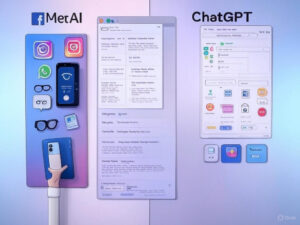Meta Steps Up the AI Race: A Deep Dive into Its New Personal AI App
Table of Contents
-
Introduction
-
Why Meta Launched a Standalone AI App
-
Voice-First: Meta’s Unique Approach
-
Memory and Personalization: The Power of Meta AI
-
Social DNA: Community Features and Discovery
-
Hardware Integration: The Ray-Ban Meta Glasses
-
User Experience: Designed for Everyone
-
Meta AI vs. ChatGPT: How Do They Compare?
-
Privacy, Ethics, and Security Concerns
-
What This Means for Indian Users
-
Conclusion
1. Introduction
Meta Platforms, the parent company of Facebook, Instagram, and WhatsApp, has launched a new standalone AI application called Meta AI. This move signals Meta’s ambition to become a leader in the generative AI space, challenging OpenAI’s ChatGPT and Google’s Gemini. With over a billion users already interacting with Meta AI across its platforms, this new app aims to make AI more personal, social, and accessible than ever before237.
2. Why Meta Launched a Standalone AI App
-
Competition is Heating Up: OpenAI’s ChatGPT has dominated the generative AI market, and Google has launched its own Gemini AI. Meta needed a strong answer to stay relevant and innovative68.
-
AI for Daily Life: Meta wants to make AI a part of everyday digital experiences, not just a tool for techies or businesses23.
-
One App, Many Uses: Instead of hiding AI inside social media, Meta now offers a dedicated app for AI-powered assistance, creativity, and discovery35.
3. Voice-First: Meta’s Unique Approach

-
Voice as the Main Interface: Unlike most AI chatbots that rely on text, Meta AI is designed for natural, low-latency voice conversations. You can talk to it like you talk to a friend, making it more accessible for users who aren’t comfortable typing long queries35.
-
Full Duplex Conversations: Meta AI supports bidirectional voice chat, meaning you can interrupt or interject-just like a real conversation3.
-
Focus on Realism: The voice experience is highly expressive and feels more human, aiming to make AI interactions as natural as possible3.
4. Memory and Personalization: The Power of Meta AI
-
Long-Term Memory: Meta AI remembers details you share, such as your children’s names, birthdays, or interests. This allows for more personalized and meaningful conversations in the future35.
-
Social Integration: By connecting your Facebook and Instagram accounts, Meta AI can learn about your hobbies and preferences, making its responses even more relevant3.
-
User Control: Meta promises that users will have control over what context is shared and remembered, addressing privacy concerns35.
5. Social DNA: Community Features and Discovery

-
Discover Feed: Meta AI includes a “discover” feed, where you can see how others are using the app for homework, creative projects, or coding3.
-
Prompt Sharing: Users can view, share, and remix prompts and outputs, making AI learning more social and collaborative-similar to how trends spread on Instagram or Facebook3.
-
Community Building: Meta leverages its strength in building online communities to make AI exploration fun and engaging for everyone3.
6. Hardware Integration: The Ray-Ban Meta Glasses
-
Smart Glasses Connection: Meta AI is tightly integrated with Ray-Ban Meta smart glasses, allowing you to ask questions about what you see in real time and get answers through voice25.
-
Next-Gen Computing: Mark Zuckerberg believes these glasses could become the next major computing platform, moving beyond smartphones to wearable AI assistants25.
-
Unique Advantage: This hardware-software integration sets Meta apart from OpenAI and Google, who don’t yet offer similar products25.
7. User Experience: Designed for Everyone
-
Easy to Use: Meta AI is available as a web app and mobile app, with simple onboarding and a user-friendly interface3.
-
Creative Tools: The app includes free image generation, a visual editor, and tools for prompt engineering-features that are often paid in other AI platforms3.
-
For Beginners and Experts: Whether you’re new to AI or an experienced user, Meta AI is designed to be accessible and useful for all35.
8. Meta AI vs. ChatGPT: How Do They Compare?

| Feature | Meta AI | ChatGPT |
|---|---|---|
| Integration | Deeply tied to Meta platforms (FB, IG, WhatsApp) | Standalone, widely available |
| Voice Interaction | Voice-first, full duplex, natural conversations | Voice available, but text-focused |
| Memory | Long-term, cross-app memory with social integration | Session-based, less persistent |
| Social Features | Discover feed, prompt sharing, community tools | Limited social/community features |
| Hardware Integration | Ray-Ban Meta glasses, AR/VR focus | No direct hardware integration |
| Customization | Limited to Meta ecosystem | Highly customizable with custom GPTs |
| Privacy/Ethics | User control, but more data from social profiles | Transparent, but less social data |
Meta AI is ideal for users already active on Meta platforms and those who want a social, voice-driven AI. ChatGPT remains the top choice for broad, customizable, and text-heavy tasks68.
9. Privacy, Ethics, and Security Concerns
-
Data Privacy: With deep integration into social media and long-term memory, Meta AI collects and processes a lot of personal data. This raises concerns about surveillance and data misuse6.
-
Ethical Safeguards: Meta claims to use ethical AI frameworks, bias mitigation, and lets users opt out of data training1.
-
Transparency: As AI becomes more personal, maintaining transparency about how data is used and stored is critical. Users should regularly review privacy settings and data sharing permissions16.
10. What This Means for Indian Users
-
Wider Accessibility: With a billion users across Meta’s platforms, Indian users can easily access Meta AI through Facebook, Instagram, or WhatsApp7.
-
Local Relevance: Meta AI’s voice-first approach and memory features can make digital assistance more relevant for Indian families, students, and small businesses.
-
Language Support: Meta AI is expected to support multiple Indian languages, making it useful for a diverse audience1.
-
Opportunities and Cautions: While Meta AI promises convenience and creativity, users should stay alert about privacy, data sharing, and ethical use.
11. Conclusion
Meta’s new standalone AI app is a bold step in the global AI race. By focusing on voice, memory, and social features, Meta aims to make AI more personal and indispensable in our daily lives. For Indian users, this means easier access to cutting-edge AI, but also a need to stay informed about privacy and ethical issues.
As the AI landscape evolves, Meta AI and ChatGPT will continue to push each other, bringing more innovation and choices for users everywhere. The future of AI is here-and it’s getting more personal every day.
1 thought on “Meta Steps Up the AI Race: A Deep Dive into Its New Personal AI App”